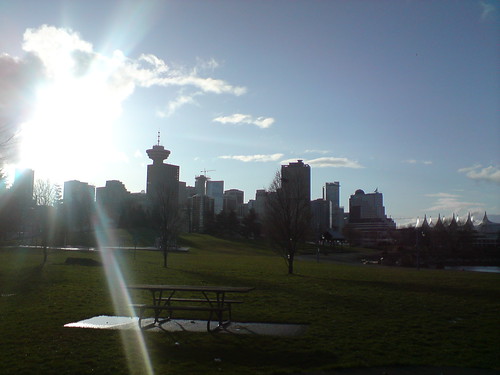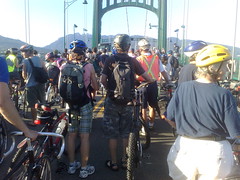 Vancouver’s evolutionary urban and industrial development trajectories have been documented by several scholars (Barnes et al, 1992, Hutton 1997, 2004, Barnes and Hutton 2009) in the past couple of decades. The city of Vancouver’s planning processes and departments have also been lauded in the popular press as well as in the academic literature as being ‘cutting-edge’ and innovative.
Vancouver’s evolutionary urban and industrial development trajectories have been documented by several scholars (Barnes et al, 1992, Hutton 1997, 2004, Barnes and Hutton 2009) in the past couple of decades. The city of Vancouver’s planning processes and departments have also been lauded in the popular press as well as in the academic literature as being ‘cutting-edge’ and innovative.
With burgeoning electronic arts, gaming and information technology industries, Vancouver industrial base appears to be poised to become fundamentally a creative/information society. Clusters of Information Technology (IT) firms have emerged in Gastown and Yaletown (an area that used to be primarily derelict industrial) and this area continues to flourish with new tech-based startups (Hutton 2008). Vancouver isn’t the first city where this has occurred. Several European (including Barcelona and Milan) and Latin American cities have experienced the growth of information-based industries (a process that I have called tertiarization – Pacheco-Vega 2008, Evans 2009).
When I conducted my doctoral dissertation research, I focused on the evolutionary transformation of two cities and the industrial clusters that were embedded in them. I have been puzzled by the re-emergence of a trend to change land use from industrial to residential, sparked in part by the decline of industrial activity in certain urban centres. This coupled industrial/urban restructuring presents a number interesting challenges: how can we provide enough land for residential purposes and what to do about the shifting industrial base in the city.

In a city that is contained and encased (surrounded by oceans on one side and by other municipalities at the south and east), Vancouver has no additional land base to grow horizontally and therefore, planners in this city have needed to consider vertical growth and increased urban density. At the same time, an increasing amount of industrial land has been shifted to residential use (for example, the case of the South East False Creek area).
Both themes (the evolutionary dynamics of urban/industrial land use and the need for increased density) are worthy of examination, and I plan to write about them on this blog in the near future, but for now, I want to just focus on the second one (increased density), since it’s the topic of the recently approved laneway housing proposal that is embedded within the EcoDensity initiative. For those not familiar with EcoDensity, you can read the full Executive Summary of the initiative.
 A cursory and preliminary literature review (using Google Scholar and library databases) yielded very little to no academic analysis of the initiative itself (a surprising finding, I might add). I did find some articles and a Masters thesis that dealt in some tangential way with the initiative, but nothing really in-depth on the initiative itself (which gives me great hope for this being a good research project). I am puzzled about EcoDensity (and frankly, skeptical) for several reasons:
A cursory and preliminary literature review (using Google Scholar and library databases) yielded very little to no academic analysis of the initiative itself (a surprising finding, I might add). I did find some articles and a Masters thesis that dealt in some tangential way with the initiative, but nothing really in-depth on the initiative itself (which gives me great hope for this being a good research project). I am puzzled about EcoDensity (and frankly, skeptical) for several reasons:
First, affordability is dependent not on the capacity of home buyers or renters to purchase or rent, but on the price that developers and renters charge. This price is not controlled by the government and therefore one of the two “auxiliary” wheels in the EcoDensity charter ends being a moot point. Last year you could easily read the advertisements for “spacious 480 sq ft” apartments priced in the $ 300,000 mark (in Vancouver).
Second, livability has embedded substantial psychological considerations. The psychology of buyers and/or renters can’t be influenced by policy decisions. I currently live in a small apartment that is near 500 sq ft. For me, compared to my parents’ house, this apartment is ridiculously small. For me, it’s livable. I don’t know if my parents would have chosen to live in such a small space. For many of my friends, the idea of a house (single family dwelling) with a backyard is what they would call a livable home.
Third, increased density doesn’t guarantee increased sustainability. There are strong arguments in favor of the idea that increased density leads to a lower ecological footprint, including the fact that having more dense regions would mean that residents would have access to more services (and they would be able to reach there by more sustainable, less-impacting means – including walking and/or cycling). But there is no guarantee that this will be the case. The element that policy makers seem to forget here is that behavioral change is not easy. I can assure you that there are people who live in really dense areas who still drive just a few blocks (I’ve witnessed this myself).
I am really curious to see the actual effect of laneway housing and secondary suites on housing affordability. While I am glad that the city recognizes that affordability is a complex issue, I would like to see a more fleshed-out scheme within the EcoDensity charter to influence affordability.
As I mentioned at the beginning of this post, these are just preliminary thoughts. I’ve always been intrigued by the urban planning processes of the city that I’ve called home for almost a decade, and the EcoDensity initiative (and the collateral discussions) could be a good case study. Now, if I only had a research grant to undertake such analysis!
I am, as always, interested in your thoughts on EcoDensity, the laneway housing proposal, the secondary suites proposal.

![]() photo credit: Latvian Foreign Ministry
photo credit: Latvian Foreign Ministry









Recent Comments